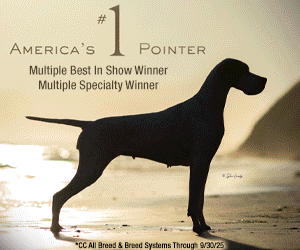From The CC Vault: The Power of the Pedigree
By William J. Given
Originally published: December 2014
 Whether you have made the decision to breed your first litter or your next litter, your decision provides you with a wonderful opportunity to become more knowledgeable about the history of your breed and the make-up of some of your favorite stud dogs. For those on tight budgets, the mixing and matching of pedigrees on paper is safer and a much more cost-effective method than experimenting with your cherished grand champion. Your pedigree research may even be the key that cracks the code and unlocks the secrets that could prove crucial to future breedings that just might create a new dynasty of canine superiority.
Whether you have made the decision to breed your first litter or your next litter, your decision provides you with a wonderful opportunity to become more knowledgeable about the history of your breed and the make-up of some of your favorite stud dogs. For those on tight budgets, the mixing and matching of pedigrees on paper is safer and a much more cost-effective method than experimenting with your cherished grand champion. Your pedigree research may even be the key that cracks the code and unlocks the secrets that could prove crucial to future breedings that just might create a new dynasty of canine superiority.
Many people find the very thought of pedigree study enough to send them straight to sleep. In recent years it has become commonplace to hear people say disparagingly that a pedigree is nothing but a list of names that is useless as a tool for comparison between individuals and bloodlines. To breed and raise show dogs, their reasoning goes, it is far more productive to consider phenotype (the scientific way of saying conformation, or the way a dog looks as a result of the combination of inherited genes and the effect of the animal’s environment) than to waste time researching pedigrees. Others maintain the fact that good show dogs come in an array of shapes, sizes, colors, and heritages. Yes, the notion leaves me scratching my head in bewilderment.
How on earth can a person make any realistic assessment of the probable inheritance of either a genotype or phenotype without knowing which of the names in a pedigree are responsible for passing on which traits with any regularity? How many of these dogs can be counted on to reproduce their finest qualities consistently through future generations? How many of these superior traits were deliberately selected for, and how many were the result of a lucky brush stroke across the pallet of proven genetic power?
A breeder’s success is directly proportional to his or her ability to produce superior show dogs breeding after breeding. A good eye and wonderful instincts as a breeder are certainly important but more is required. And while success does not require obtaining an advanced degree in genetics, it does require a good working knowledge of the prominent lines in your breed and of the overall quality of the get produced when bred with one another both within and outside of the confines of their individual bloodlines.
The American Kennel Club makes certified four and five generation pedigrees available for purchase to every breeder. Each AKC certified pedigree includes complete information about every dog in the pedigree. Along with the names and registration numbers, this information includes colors and markings, competition titles and any health-related information available including AKC DNA registration information.
There are literally dozens of good books written on the topic of canine genetics that thoroughly discuss the practical application of genetic principals through pedigree analysis. These books are read and re-read by the serious and highly successful breeders in the quest to find the perfect “mesh” (breeding of dogs from specific bloodlines that consistently result in offspring of physical similarity and predictable quality). It is the stuff of every breeder’s dreams, as well as the crosses and outcrosses that will allow them to breed better dogs that are more consistent winners in the ring.
Our dogs deserve at least this much forethought and dedication. Knowing the sire, dam and grandparent is not nearly as telling as knowing their history to the fourth or even fifth generations, where all sorts of surprises (both pleasant and disturbing) may dwell in the darkness of decades past. It is important to know how lines nick, why they do well and why they don’t, which dogs pass on specific traits through the generations with the greatest predictability and which dogs do not, which dogs are prepotent for the correct head, rock solid topline, sound movement, proper coat, and showmanship you covet and why. Consider, also, whether your dogs are inbred and how closely, and what might happen to the future of your breeding program if you use Grand Champion Mister Majestic on his niece that is your beloved companion and a multiple specialty winner.
Any breeder who has bred a few litters knows that a successful mesh is produced by more than just putting this year’s winningest stud dog to their best and favorite bitch. Unfortunately, it is not at all terribly uncommon to breed two truly outstanding individuals and get a few puppies that you would swear were a mistake. Looking at the two dogs involved on the basis of conformation, temperament, and so on may not illustrate why the mating did not work as you had expected. A study of the pedigree just might reveal certain recessive traits common to both bloodlines concerned that combined to create the less desirable characteristics you had hoped would not be present.
It is no wonder that many breeders find researching pedigrees a daunting task. A five generation pedigree contains sixty-two names. That is more than enough to cross your eyes or bring on a massive headache for any breeder, and if an individual is coming to the breeding process with little or no prior experience, it must assuredly seem incomprehensible. Most of us cannot even trace our own families that far back. Fortunately, the impact of fourth and fifth generation ancestors will normally be minimal. The first three generations are genetically the most significant when speaking to any real effect on inheritance, and will be your most frequently looked-at reference. You will, of course, find that over time the generations further back will begin to make more sense as the names of the dogs are recalled often enough to give you a reason to remember them.
Reading a pedigree is really quite simple. The first two lines after your dog’s name and the details of birth, list its sire on the top and its dam on the bottom. The second generation lists the four grandparents, and the third lists eight great-grandparents, for a total fourteen. The names of the stud dogs always occupy the top, so that the male line progresses along the top line of the pedigree chart. The names of the dams always occupy the bottom, and the female line is traced along the bottom side of the pedigree.
If you wish to refer to the stud dog’s female family, you simply put your finger on the sire’s dam and follow that line down his chart. For the dam’s male ancestry, follow her sire’s line up. No matter where on the pedigree you begin, the method of movement up, down and across the pedigree chart is the same.
A pedigree that is just a list of names largely unknown to you is not going to be a great deal of help in choosing breeding stock unless you acknowledge that each of the names represents an individual dog that has established a history of success in the show ring, as a producer, or is a relative of other dogs known to be successful in either or both of these areas.
Each and every dog that appears on the pedigree contributes something to your dog’s individual genetic makeup that will affect its conformation, overall soundness and temperament. On the most simplistic level, you can judge roughly what kind of effect this will be by designating values to the position of each name that appears; fifty percent to the sire and dam, twenty-five percent to the grandparents, twelve-and-a-half percent to the great-grandparents, and so forth. This is immediately complicated by the fact that you cannot be precisely sure which 50 percent has been passed by each parent. Obviously, all things being equal, an exchange based on one particular great-grandparent is not going to have an enormous effect on your final product. But this also depends on the inheritability of certain traits, the prepotency (or genetic dominance) of certain animals in passing specific essential strengths or weaknesses, and the effects of linebreeding, inbreeding and outcrossing.
If, for instance, the great-grandparent mentioned above had a dominant trait shared by all in the bloodline (a condition in genetics that points to the presence of “homozygosity,” in which alleles are always dominant and override other combinations), then chances are it will show up in your dog as well. This genetic hocus-pocus is the same thing that determined the many elements that combined to give you “your grandfather’s nose or your grandmother’s eyes.” On a basic level, it also describes how breeders begin selecting for specific positive traits to single out as breeding goals. Deliberately breeding for certain dominant traits is the basis of the creation of every breed, and eventually determines not only the size and shape, but color, health and temperament as well.
Selective breeding for specific characteristics can backfire, however. Occasionally certain recessive weaknesses, those traits that have not been conspicuous because they have been masked by visible dominant traits, can make an unwelcome appearance when combined with the same recessive allele from the other dog. This explains the seemingly incomprehensible miscalculation that occurs in every breeder’s life, most of which are not really as cryptic as they seem when analyzed more closely.
Once you recognize the names on a pedigree and can recall what it is about them that either rings the warning bells or evokes a positive picture, patterns of similarity will begin to materialize that illustrate corresponding characteristics in conformation, soundness and temperament, for good or bad.
It is really quite reasonable that you expect that the stud dogs that consistently appeal to you, for whatever reasons, should have a prepotency for some combination of desirable traits that are common to their entire line. These lines do certainly exist in every breed. At a show or over coffee, you could easily find yourself in conversation with a breed colleague discussing the benefits of using GCH Mister Majestic due to the fact that his offspring always prove to be excellent show dogs when bred to bitches of bloodline X.
Genetically speaking, there is a vast reservoir of reasons as to why this is the case. Practically speaking, your knowledge of the pedigrees of the dogs involved and the experience you gain in the application of fundamental genetic principals is extremely valuable when selecting the show dogs that will serve as your breeding stock, especially the foundation bitch, and in planning the breedings designed to produce your next generation of show winning dogs. Your ability to translate a printed pedigree into superior conformation and outstanding show ring performance will significantly minimize the possibility of any of the nasty surprises that lie undiscovered in your bloodline.
Short URL: http://caninechronicle.com/?p=266721
Comments are closed












